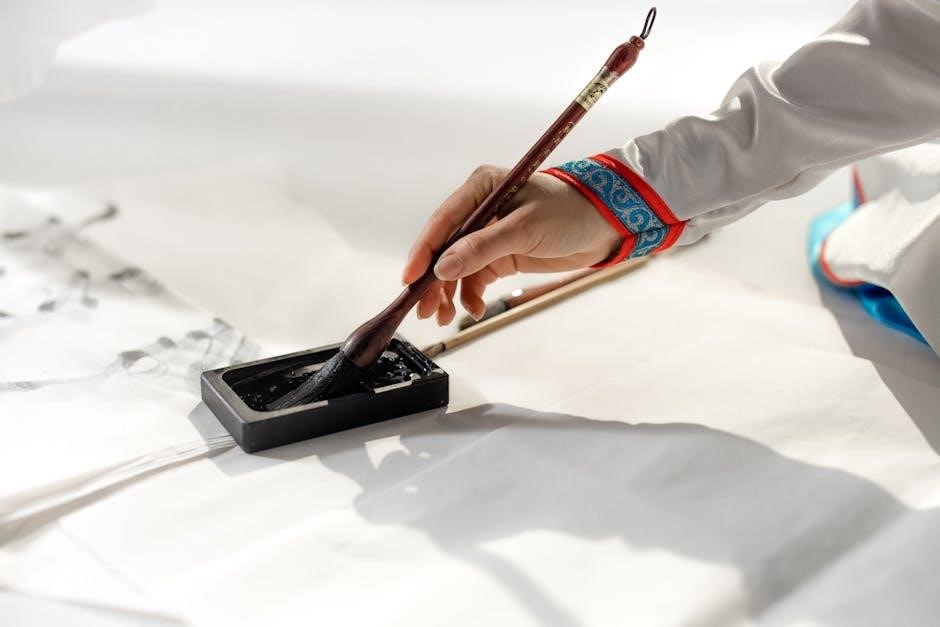A Digital Signature Certificate (DSC) is a secure digital key used for authenticating and encrypting documents․ It plays a crucial role in patent applications by ensuring the integrity and legality of e-filings, streamlining processes, and meeting regulatory requirements․
1․1․ Understanding Digital Signature Certificates (DSC)
A Digital Signature Certificate (DSC) is a digital key issued by a certified authority, used to validate the identity of individuals or organizations․ It ensures document authenticity, integrity, and non-repudiation, making it essential for secure digital transactions․ DSCs are typically valid for 1-3 years and are used for signing, encrypting, or both․ They are legally recognized and comply with IT Acts, ensuring trust in digital processes like patent filings, tax submissions, and legal documents․
1․2․ Role of DSC in Patent Application Filing
Digital Signature Certificates (DSCs) are essential for securely signing and submitting patent applications online․ They authenticate the identity of the applicant, ensuring the legality and integrity of the filing․ DSCs replace handwritten signatures, streamline the e-filing process, and comply with legal requirements․ They also protect documents from tampering, maintaining confidentiality․ Once obtained, a DSC can be used for multiple patent applications, making it a convenient and efficient tool for applicants․

Benefits of Using DSC for Patent E-Filing
DSC enhances security, streamlines submission, and ensures compliance with legal requirements․ It simplifies the patent filing process and verifies the authenticity of digitally signed documents efficiently․
2․1․ Enhanced Security and Authentication
DSC ensures robust security by encrypting documents and verifying the signer’s identity․ It prevents tampering, making patent applications tamper-proof and legally valid․ The use of cryptographic technology ensures data integrity, while secure encryption prevents unauthorized access․ This enhances trust in digital transactions and maintains confidentiality throughout the patent filing process․
2․2․ Streamlined Submission Process
DSC simplifies the patent application process by eliminating manual signatures and physical submissions․ Applicants can upload documents and sign them digitally, reducing time and effort․ The electronic submission system ensures faster processing and minimizes logistical challenges․ This streamlined approach increases efficiency, making it easier for applicants to meet deadlines and track their submissions online․ It aligns with modern digital workflows, enhancing overall user experience and productivity․
2․3․ Compliance with Legal Requirements
DSC ensures adherence to legal standards for digital signatures in patent applications․ It verifies the authenticity of submissions and prevents repudiation, aligning with regulatory demands․ The use of DSC is mandated for e-filing patents, ensuring compliance with digital signature laws․ Failure to use a valid DSC can result in rejection or delays․ This compliance fosters trust and integrity in the electronic submission process, making it a critical requirement for patent offices worldwide․

Eligibility Criteria for Obtaining a DSC
Individuals and organizations can obtain a DSC if they meet specific requirements, such as providing valid identity proof and being authorized to represent the entity․
3․1․ Individuals Eligible for DSC
Individuals eligible for a DSC include those with valid identity and address proof․ They must be authorized to represent themselves or their organization in legal matters․ Applicants must provide documents like PAN, Aadhaar, or passports․ The issuing authority verifies the details before granting the certificate․ This ensures only legitimate individuals obtain a DSC for patent applications and other legal purposes, maintaining authenticity and compliance with regulations․
3․2․ Organizations Eligible for DSC
Organizations, including businesses, partnerships, and non-profits, are eligible for DSCs․ They must provide proof of incorporation, PAN cards, and GST registrations․ Authorized representatives, such as directors or proprietors, can apply on behalf of the organization․ Foreign entities may require additional documentation; The DSC ensures secure authentication for e-filings, including patent applications, and complies with legal standards․ It is typically valid for 1-3 years, depending on the issuing authority’s guidelines․

Step-by-Step Guide to Obtaining a DSC
Obtaining a DSC involves selecting a certified authority, submitting required documents, completing the application form, and paying fees․ Post-verification, the certificate is issued for secure use in patent filings․
4․1․ Required Documents for DSC Application
To apply for a DSC, individuals must provide identity and address proofs, such as Aadhaar, PAN, or passport․ Organizations need incorporation certificates, PAN cards, and an authorization letter․ Ensure all documents are valid and updated to avoid delays in the verification process․ Additional requirements may vary based on the certifying authority and the type of DSC applied for․
4․2․ DSC Application Process
The DSC application process begins with selecting the appropriate certificate type․ Applicants must fill out the online application form, upload required documents, and complete the payment process․ Post-payment, a key generation process is initiated, followed by a remote or in-person verification․Once verified, the DSC is issued and sent via email or downloaded from the provider’s portal․ Ensure all steps are completed accurately to avoid delays in obtaining the certificate․
4․3; Verification and Approval Process
After submitting the DSC application, the certifying authority verifies the documents and conducts identity validation․ This may involve video verification or physical checks․ Once verified, the applicant receives an approval email․ The DSC is then issued and delivered via email or downloaded from the provider’s portal․ Ensure all details are accurate to avoid rejection․ The process typically takes 1-3 working days, depending on the provider and application completeness․

Installing and Configuring DSC
Procure the DSC, install drivers, and configure settings․ Ensure system meets requirements and browsers are set up for compatibility․ Proper installation is key for smooth functionality․
5․1․ System Requirements for DSC Installation
The system must have a Windows OS (7, 8, or 10), with the latest updates installed․ Ensure Internet Explorer (version 9 or higher) or compatible browsers are configured․ Install capicom․dll to enable DSC functionality․ A valid Java Runtime Environment is also required․ Ensure all prerequisite software is updated and compatible with your DSC․ These requirements ensure smooth installation and proper functioning of the DSC for patent applications․
5․2․ Installation of DSC Drivers and Software
Download the DSC drivers and software from the certified authority’s website․ Run the installer, following on-screen instructions to install the necessary drivers․ Ensure Java Runtime Environment is updated․ Restart your system after installation․ Install additional software, such as utility tools, to manage your DSC․ Verify installation by checking for DSC-related icons or settings in your system․ Ensure proper configuration to enable seamless integration with patent application portals․ Administrative privileges may be required for installation․
5․3․ Configuring DSC for Patent Application
After installing the DSC drivers and software, configure the settings to align with patent application requirements․ Ensure the DSC is integrated with the patent office’s online portal by registering and linking it to your account․ Install CAPICOM․DLL if required for compatibility․ Adjust encryption settings and signature formats to meet legal standards․ Verify the setup by testing the digital signature on a sample document․ Ensure system requirements like Java Runtime Environment are up-to-date․ Follow specific guidelines provided by the patent office or DSC issuer for seamless functionality and security․
Registering DSC with the Patent Office
Registering your DSC with the patent office involves creating an account, linking your DSC, and verifying its authenticity to ensure secure and recognized digital signatures․
6․1․ Creating an Account on the Patent Office Portal
Creating an account on the patent office portal is the first step in registering your DSC․ Visit the official website, fill in required details like name, email, and password․ After submitting, you’ll receive a verification link via email․ Click on it to activate your account․ Ensure all information is accurate to avoid issues during DSC linking and patent application processing․ This step ensures secure access to e-filing services and maintains the integrity of your submissions․
6․2․ Linking DSC to Your Patent Office Account
After creating your account, navigate to the account settings section․ Select the option to link your DSC․ Upload your DSC file or enter the required credentials․ Enter your DSC password to authenticate․ Once verified, your DSC will be linked to your account․ You’ll receive a confirmation notification․ Ensure your DSC is valid and not expired․ This step enables secure digital signatures for patent applications․ Troubleshoot any issues by checking DSC details or contacting support․
6․3․ Verification of DSC by the Patent Office
After linking your DSC, the Patent Office verifies its authenticity․ The system checks the certificate’s validity, ensuring it is not expired․ Once verified, you receive a confirmation․ If issues arise, such as an expired DSC or mismatched details, troubleshoot by updating your DSC or contacting support; Successful verification enables secure e-filing of patent applications․ This step ensures compliance with legal standards and maintains the integrity of the submission process․

Digitally Signing a Patent Application
Digital signatures ensure authenticity and security for patent applications․ Using a DSC, applicants can securely sign and submit documents, streamlining the process and ensuring compliance with legal requirements․
7․1․ Preparing Your Patent Application for Digital Signature
To prepare your patent application for digital signing, ensure all documents are complete and formatted correctly․ Convert the application into a PDF or acceptable digital format․ Verify that the document supports digital signatures and aligns with the patent office’s requirements․ Ensure your DSC is installed and configured properly on your system․ Double-check all information for accuracy before proceeding to sign, as errors may require resubmission․
7․2․ Steps to Sign the Patent Application Using DSC
To sign the patent application using DSC, open the document in a compatible software like Adobe Acrobat․ Locate the signature field or create one if needed․ Select your DSC from the available certificates, enter your PIN when prompted, and confirm the signature․ Ensure the signature is placed correctly and visible․ Once signed, save the document and verify the signature properties to confirm its authenticity․ This ensures compliance with legal standards for digital signatures․
7․3․ Verifying the Digital Signature
After signing, open the document in a PDF reader like Adobe Acrobat․ Click on the digital signature to view its properties․ Check the validity of the certificate, ensuring it hasn’t expired or been revoked․ Verify the signer’s details and the timestamp․ This process confirms the signature’s authenticity and ensures the document hasn’t been tampered with, maintaining compliance with legal and regulatory standards for digital signatures in patent applications․

Common Issues and Troubleshooting
Common issues include signature verification errors, certificate mismatches, and system incompatibility․ Troubleshooting involves checking certificate validity, browser compatibility, and software updates to resolve these problems effectively․
8․1․ Resolving DSC Installation Issues
Installation issues often arise due to outdated drivers or incompatible software․ Ensure your system meets the prerequisites, such as Windows version and browser compatibility․ Disable antivirus temporarily and reinstall drivers․ If problems persist, contact the certifying authority for support or refer to the user manual provided with the DSC utility․ Proper installation is crucial for seamless patent application processes, so thorough troubleshooting is essential before proceeding․
8․2․ Troubleshooting Digital Signature Errors
Digital signature errors often occur due to driver issues or incorrect browser settings․ Ensure the DSC drivers are properly installed and compatible with your system․ Check if the certificate is expired or revoked by verifying its status on the certifying authority’s portal․ Clear browser cache and restart the application․ If errors persist, re-register the capicom․dll file or reinstall the DSC utility․ Always ensure the system is updated and free from conflicts to avoid signature verification failures during patent application submissions․
8․3․ Rectifying DSC Registration Problems
Common DSC registration issues include incorrect details or system incompatibilities․ Verify the DSC details match your application and ensure the system meets requirements․ If errors persist, reinstall the DSC utility or re-register the capicom․dll file․ Contact the certifying authority for assistance with revoked or expired certificates․ Resolving these issues promptly ensures uninterrupted patent application submissions and maintains compliance with legal standards for digital signatures․

Legal and Compliance Aspects
Digital Signature Certificates are governed by legal frameworks ensuring authenticity and security in patent applications, with strict compliance requirements to maintain integrity and trust in digital transactions․
9․1․ Laws Governing DSC Usage in Patent Applications
The use of Digital Signature Certificates in patent applications is regulated by specific legal frameworks, ensuring compliance and authenticity․ Laws such as the Information Technology Act in various jurisdictions govern the validity and acceptance of digital signatures, equating them to handwritten signatures․ These regulations mandate that DSCs must be issued by licensed certifying authorities, ensuring security and trust in the patent filing process․ Compliance with these laws is essential to avoid legal penalties and maintain the integrity of patent applications․
9․2․ Compliance Requirements for Digital Signatures
Compliance with digital signature requirements ensures the authenticity and legality of patent applications․ DSCs must adhere to standards set by certifying authorities, ensuring secure encryption and validation․ The certificate’s validity period typically ranges from one to three years, and proper installation and configuration are mandatory․ Non-compliance can result in rejected applications or legal penalties, emphasizing the importance of adhering to these requirements for seamless patent filing processes․
9․3․ Consequences of Non-Compliance
Non-compliance with digital signature requirements can lead to severe repercussions, including rejection of patent applications, delays in processing, and potential legal penalties․ Failure to adhere to standards may result in the patent office deeming the application invalid or unpromptly halting the review process․ Additionally, non-compliance can lead to financial penalties and damage to the applicant’s credibility, potentially jeopardizing future patent filings and intellectual property protections․
Best Practices for DSC Usage
Safeguard your DSC to prevent unauthorized access․ Regularly update software and maintain expiry dates․ Ensure compliance with legal standards to avoid delays and maintain document integrity securely․
10․1․ Safeguarding Your DSC
To protect your Digital Signature Certificate, store it securely, use strong passwords, and avoid sharing credentials․ Keep the DSC token in a safe location and ensure software is updated․ Monitor for unauthorized access and report any suspicious activity immediately․ Never share your DSC with third parties and always log out from systems after use․ Regular backups and encryption can further enhance security, preventing misuse and ensuring compliance with legal standards for patent applications․
10․2․ Regularly Updating DSC Software
Regularly updating your DSC software is essential to ensure security, functionality, and compatibility․ Use the built-in update tools within your DSC management utility to check for and install the latest versions․ Enable automatic updates if available to stay current effortlessly․ Outdated software may pose security risks or compatibility issues with patent filing systems․ Updates often include patches, bug fixes, and new features, ensuring smooth operation and compliance with evolving standards for digital signatures in patent applications․
10․3․ Maintaining DSC Expiry Dates
Regularly monitoring your DSC’s expiry date is crucial to ensure uninterrupted use in patent applications․ DSCs typically remain valid for 1 to 3 years, after which renewal is required․ Set reminders or track expiry dates through your service provider’s notifications․ Failing to renew on time can disrupt e-filing processes and delay patent submissions․ Plan ahead to avoid last-minute issues and maintain compliance with legal requirements for digital signatures in patent applications․ Proactive management ensures seamless operations and prevents potential delays․ Keep track of expiry dates to avoid lapses in validity․ Always renew before the DSC expires to maintain uninterrupted access to e-filing services․ This ensures your patent applications remain timely and compliant with regulatory standards․ Properly managing expiry dates is essential for maintaining operational efficiency and avoiding legal complications․ Staying vigilant about DSC validity ensures smooth patent application processes․ Remember, an expired DSC cannot be used for signing or submitting documents, so timely renewal is critical․ By keeping your DSC up to date, you ensure compliance with legal standards and avoid delays in patent filings․ Regular checks and timely renewals are key to maintaining DSC functionality․ Always prioritize expiry date management to ensure your DSC remains effective for all patent-related transactions․ This ensures your digital signature remains valid and trusted by the patent office․ Proper management of expiry dates is vital for maintaining the integrity and usability of your DSC in patent applications․ Stay informed and proactive to avoid any issues related to DSC expiration․ Keeping track of expiry dates ensures your DSC remains a reliable tool for secure and efficient patent e-filing․ Plan and act accordingly to prevent any disruptions caused by an expired DSC․ Timely renewal is essential to maintain continuity in your patent application processes․ Always monitor and manage your DSC’s expiry date to ensure it remains valid and functional for all your needs; This ensures compliance with regulations and avoids potential delays or rejections of patent applications․ Stay proactive in managing your DSC’s expiry to maintain seamless operations․ Properly managing expiry dates is essential for the effective use of DSC in patent applications․ Always ensure your DSC is up to date and valid to avoid any issues during the e-filing process․ Timely renewal is crucial to maintain the functionality of your DSC and ensure compliance with legal requirements․ By monitoring expiry dates, you can prevent lapses and ensure your DSC remains a trusted tool for digital signatures in patent applications․ Regular checks and timely renewals are key to maintaining DSC validity and ensuring uninterrupted use in patent e-filing․ Always prioritize managing your DSC’s expiry date to avoid any complications․ Stay informed and proactive to ensure your DSC remains valid and functional for all patent-related activities․ Proper management of expiry dates is essential for the effective and uninterrupted use of DSC in patent applications․ Always monitor and act on your DSC’s expiry date to maintain compliance and avoid delays․ Timely renewal ensures your DSC remains a reliable tool for secure and efficient patent e-filing․ Stay vigilant and proactive in managing your DSC’s expiry to ensure seamless operations․ Properly tracking and renewing your DSC on time is crucial for maintaining its validity and ensuring uninterrupted use in patent applications․ Always plan ahead to avoid any issues related to DSC expiration․ This ensures your digital signature remains trusted and functional for all patent-related transactions․ Proper management of expiry dates is vital for the effective use of DSC in patent applications․ Always monitor and renew your DSC in a timely manner to maintain compliance and avoid delays․ By staying proactive, you ensure your DSC remains a reliable tool for secure and efficient patent e-filing․ Regularly checking and managing your DSC’s expiry date is essential for maintaining its validity and ensuring uninterrupted use in patent applications․ Always prioritize timely renewal to avoid any complications․ Proper management of expiry dates ensures your DSC remains functional and trusted for all patent-related activities; Stay informed and proactive to maintain seamless operations․ Always monitor and manage your DSC’s expiry date to ensure it remains valid and functional for patent applications․ Timely renewal is crucial to prevent lapses and maintain compliance with legal requirements․ By staying vigilant, you ensure your DSC remains a reliable tool for secure and efficient e-filing․ Properly managing your DSC’s expiry date is essential for uninterrupted use in patent applications․ Always plan ahead and renew on time to avoid any issues․ This ensures your digital signature remains valid and trusted by the patent office․ Regular checks and timely renewals are key to maintaining DSC functionality and ensuring compliance with regulations․ Always prioritize managing your DSC’s expiry date to avoid any disruptions․ Stay proactive and informed to ensure your DSC remains a trusted tool for patent e-filing․ Properly managing expiry dates is crucial for the effective use of DSC in patent applications․ Always monitor and renew your DSC on time to maintain its validity and functionality․ This ensures compliance with legal standards and avoids potential delays․ By staying proactive, you ensure seamless operations and uninterrupted use of your DSC for patent applications․ Always track and manage your DSC’s expiry date to maintain its validity and ensure it remains functional for all patent-related transactions․ Timely renewal is essential to prevent lapses and avoid complications․ Proper management of expiry dates ensures your DSC remains a reliable tool for secure and efficient e-filing․ Stay vigilant and proactive to maintain seamless operations․ Always monitor and manage your DSC’s expiry date to ensure it remains valid and functional for patent applications․ Regular checks and timely renewals are crucial for maintaining compliance and avoiding delays․ By staying informed, you ensure your DSC remains a trusted tool for secure and efficient patent e-filing․ Properly managing expiry dates is essential for the effective use of DSC in patent applications․ Always prioritize timely renewal to maintain validity and functionality․ This ensures your digital signature remains trusted and compliant with legal requirements․ Stay proactive and informed to avoid any issues related to DSC expiration․ Regularly monitoring and managing your DSC’s expiry date is crucial for maintaining its validity and ensuring uninterrupted use in patent applications․ Always plan ahead and renew on time to prevent lapses and avoid delays․ Proper management of expiry dates ensures your DSC remains functional and trusted for all patent-related activities․ Stay vigilant and proactive to maintain seamless operations․ Always track and manage your DSC’s expiry date to ensure it remains valid and functional for patent applications․ Timely renewal is essential to maintain compliance and avoid complications․ By staying proactive, you ensure your DSC remains a reliable tool for secure and efficient e-filing․ Properly managing expiry dates is vital for the effective use of DSC in patent applications․ Always monitor and renew your DSC on time to maintain its validity and functionality․ This ensures compliance with legal standards and avoids potential delays․ Regular checks and timely renewals are key to maintaining DSC functionality and ensuring uninterrupted use in patent applications․ Always prioritize managing your DSC’s expiry date to avoid any disruptions․ Stay informed and proactive to ensure your DSC remains a trusted tool for patent e-filing․ Properly managing expiry dates is essential for maintaining the validity and functionality of your DSC․ Always monitor and renew on time to prevent lapses and ensure compliance with legal requirements․ By staying vigilant, you ensure seamless operations and uninterrupted use of your DSC for patent applications․ Always track and manage your DSC’s expiry date to maintain its validity and functionality․ Timely renewal is crucial to avoid delays and maintain trust in your digital signature․ Proper management of expiry dates ensures your DSC remains a reliable tool for secure and efficient e-filing․ Stay proactive and informed to avoid any issues related to DSC expiration․ Regularly monitoring and managing your DSC’s expiry date is essential for maintaining its validity and ensuring uninterrupted use in patent applications․ Always plan ahead and renew on time to prevent lapses and avoid complications․ Proper management of expiry dates ensures your DSC remains functional and trusted for all patent-related activities․ Stay vigilant and proactive to maintain seamless operations․ Always monitor and manage your DSC’s expiry date to ensure it remains valid and functional for patent applications․ Timely renewal is essential to maintain compliance and avoid delays․ By staying proactive, you ensure your DSC remains a reliable tool for secure and efficient e-filing․ Properly managing expiry dates is crucial for the effective use of DSC in patent applications․ Always prioritize timely renewal to maintain validity and functionality․ This ensures your digital signature remains trusted and compliant with legal requirements․ Stay informed and proactive to avoid any issues related to DSC expiration․ Regular checks and timely renewals are key to maintaining DSC functionality and ensuring uninterrupted use in patent applications․ Always prioritize managing your DSC’s expiry date

Renewing Your DSC
Renewing your DSC is essential to maintain its validity for patent applications․ Typically, DSCs expire after 1-3 years, requiring a renewal process to avoid lapses in usage;
11․1․ When to Renew Your DSC
Your DSC must be renewed before its expiry date, typically ranging from 1 to 3 years․ Ensure to track the expiry date to avoid lapses in patent application submissions․ Renewal is necessary when the certificate nears expiration, as an expired DSC cannot be used for signing documents․ Failing to renew on time may delay or invalidate pending patent applications․ Always renew your DSC before the expiry date to maintain uninterrupted e-filing capabilities and compliance with legal requirements․
11․2․ DSC Renewal Process
The DSC renewal process involves submitting a renewal application to the certifying authority․ Visit the authority’s website, fill out the renewal form, and upload required documents․ Pay the renewal fees, and the authority will verify your application․ Once approved, a new DSC with an updated validity period will be issued․ Ensure to install the renewed certificate to continue using it for patent applications․ Renewal maintains the certificate’s functionality and ensures uninterrupted e-filing capabilities․
11․3․ Impact of DSC Expiry on Patent Applications
DSC expiry can delay patent applications as signatures become invalid․ Applicants must renew their DSC before submitting or updating applications․ Failing to do so may result in rejected filings or processing halts; Ensure timely renewal to maintain legal compliance and avoid missed deadlines, which could impact application validity․ Regularly check DSC expiry dates to prevent disruptions in the patent filing process and ensure uninterrupted electronic submissions․

Future of DSC in Patent Applications
The future of DSC in patent applications lies in advanced security, AI integration, and streamlined processes, ensuring faster, more secure, and efficient digital transactions globally․
12․1․ Emerging Trends in Digital Signatures
Digital signatures are evolving with advancements in AI and blockchain, enhancing security and efficiency․ Integration with platforms like Windows 11 and AI-driven tools streamlines patent e-filing, ensuring authenticity and compliance․ As legal frameworks adapt, DSCs are becoming integral to global patent systems, fostering trust and innovation in digital transactions․
12․2․ Potential Enhancements to DSC Technology
Future DSC advancements may include biometric integration, enhanced encryption protocols, and AI-driven threat detection․ These innovations aim to boost security, simplify user experiences, and ensure seamless integration across platforms․ Such enhancements will likely comply with evolving global standards, making DSCs even more vital for secure digital transactions in patent filing and beyond․
12․3․ Impact of AI on DSC and Patent Filing
AI is revolutionizing DSC and patent filing by automating processes like patent drafting and analysis․ AI-powered tools can integrate with DSCs to enhance document security and ensure compliance․ This synergy streamlines the e-filing process, reduces errors, and improves efficiency, making patent applications faster and more reliable while maintaining legal standards․
Digital Signature Certificates (DSCs) are essential for secure and efficient patent application filing․ They ensure authenticity, compliance, and streamlined processes, making them indispensable for modern patent e-filing systems․
13․1․ Summary of Key Points
Digital Signature Certificates (DSCs) are essential for secure patent application filing․ They ensure authenticity, compliance, and efficiency, streamlining the e-filing process․ DSCs provide legal validity, enhance security through encryption, and simplify submission procedures․ Proper installation, registration, and maintenance of DSCs are crucial for seamless operations․ Troubleshooting common issues and adhering to compliance standards ensure uninterrupted patent filing․ Overall, DSCs are indispensable for modern patent applications, offering a reliable and efficient digital solution․
13․3․ Encouragement for Adopting DSC
13․2․ Final Thoughts on DSC Usage
Digital Signature Certificates (DSCs) are a cornerstone of secure and efficient patent application filing․ They ensure authenticity, compliance, and streamlined processes, making them indispensable for modern patent practices․ By leveraging DSCs, applicants can enhance security, reduce errors, and maintain legal integrity․ As technology evolves, DSCs will remain a critical tool for safeguarding intellectual property and facilitating seamless digital transactions․ Their adoption is not just beneficial but essential for navigating the increasingly digital landscape of patent applications․
